The Samoyed hails from Siberia, where it was bred as a working dog for the nomadic Samoyede people. Its double coat of fur ensured that it stayed warm, even in the most extreme cold weather. Sometimes called ‘Sammie’ for short, Samoyeds are known for their strength, agility, and endurance. They were used to pull sledges and serve as hunting, herding, and tracking dogs, as well as hiking companions. They also functioned as furry blankets on cold nights by sleeping on top of their owners. They were introduced to the rest of the world in the late 19th to early 20th century, when they were used in early Arctic expeditions. A member of the Spitz family, it is also known by other names like Bjelkier, Samoiedskaya Sobaka, Nemetskaya Laika.
Temperament: Smiling Sammie
The Samoyed is known for its constant smile. This adorable trait actually has a purpose—it stops the dog from drooling, thus keeping icicles from forming on its face. It’s also what makes it a popular choice among dog lovers.
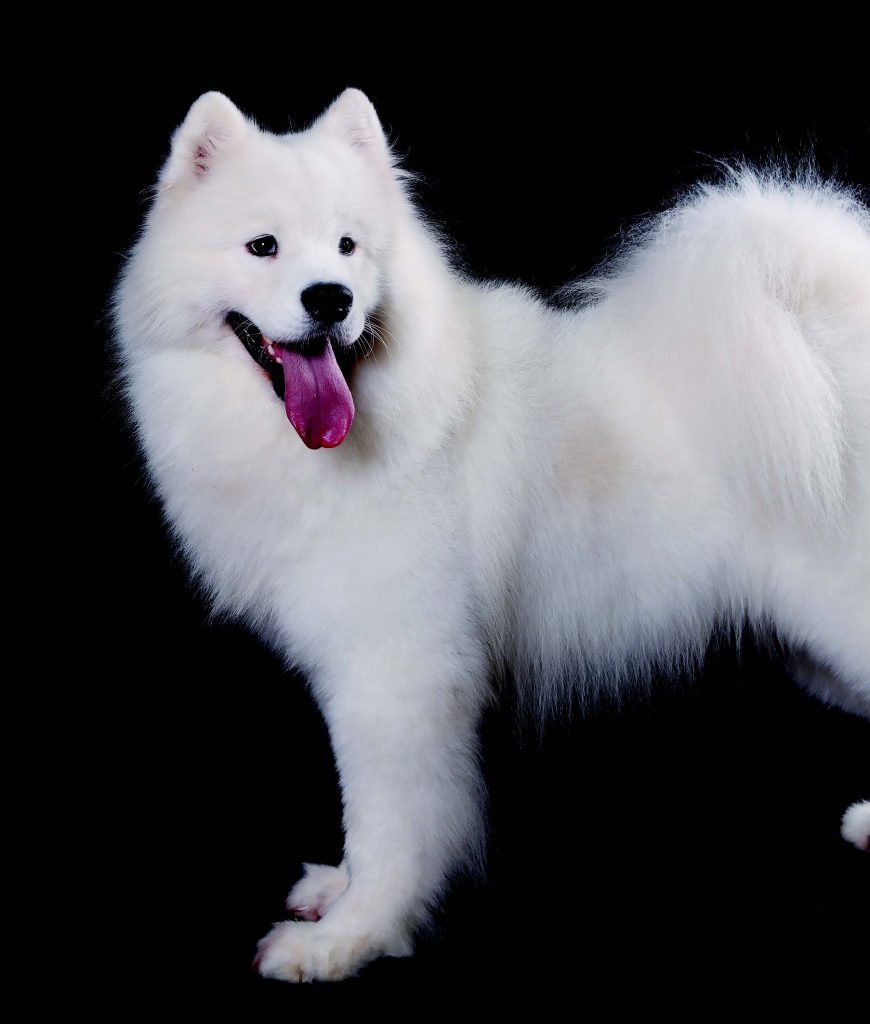
Philippine Grand Champion Polar Mist N Glacial Fire’s A Song of Fire N Ice “Ghost”
The Samoyed may look imposing, but its friendly nature makes it a poor choice for a guard dog. Its tendency to bark whenever something encroaches on its territory, however, makes it an excellent watchdog.
When properly socialized, the Samoyed can be friendly and playful, a great companion to children and even other dogs. It’s important to keep the Samoyed active and interested through games, regular walks, and if possible, dog sports. The bored Samoyed tends to resort to digging. Its herding and hunting instinct sometimes kicks in, which means that it will sometimes chase small animals (so keeping it on a leash when outside is important) or herd children!
“Being a breed belonging to the spitz group, Samoyeds are not like the Golden Retrievers of dog training. They have a mind of their own and would always attempt to do things their way. On training a Sammy, one must know the dog and what drives it to work; it could be food or toys. Once identified, the training sessions should be short, firm and consistent but fun, creative and exciting because samoyeds tend to get bored easily,” says veterinarian, breeder, and trainer Dr. Reuter King M. Bernardo, DVM of Glacial Fire Samoyeds, owner of Ghost and Loki, who also posed for the shoot.
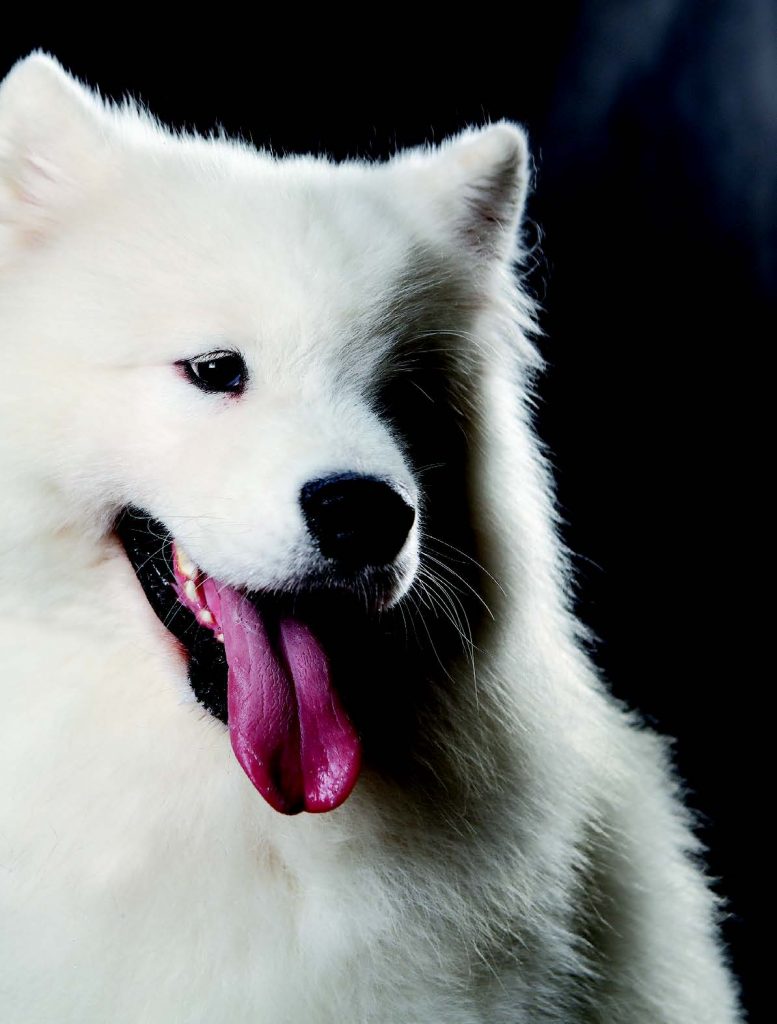
Philippine Grand Champion Polar Mist N Glacial Fire’s A Song of Fire N Ice “Ghost”
The breed is social, active, and affectionate, and can make a great pet for the family that has the energy and resources to care for it. “I think a samoyed can fit in into anyone’s family for as long as its needs are given. However, I might say that Samoyeds are not for first time dog owners because they are very demanding to attention and care. Also, being a member of the spitz family, they can be very stubborn and that will put your patience to test many times,” Dr. Bernardo adds.
Grooming: High Maintenance Beauty
The Samoyed’s distinct coat is what got Dr. Bernardo interested in the breed. “I’ve always wanted a white fluffy dog because the brother of my elementary classmate used to bring his pet Japanese Spitz to school during dismissal. When my sister acquired her first pet dog back in 2007, I took the chance on asking my parents for my own white fluffy dog. Initially, I wanted a Japanese Spitz but at the same time, I also wanted a bigger dog. I searched online and found out about Samoyeds,” he says.

Philippine Grand Champion Polar Mist N Glacial Fire’s A Song of Fire N Ice “Ghost”
While the Samoyed can be a gentle breed, it is also most definitely a high-maintenance one. To survive the cold weather, the Samoyed’s coat is composed of a long, rough outer coat and a thick, soft undercoat. Most Samoyed coats are white, though they can also be cream and biscuit (have a brownish tint). Since the Philippines is a tropical country, it’s important to keep Samoyeds away from the heat.
“The Samoyed, although a nordic breed, is an adaptable breed of dog. The double coat feature of the breed traps cold air that keeps them cool on warmer days and that is why shaving or trimming the coat is not advised. However, this does not mean that they are not prone to heat stress. As much as possible, pet owners should give a well ventilated area with aircon or a fan at least and lots of water,” Dr. Bernardo says.
The breed sheds a lot, especially during shedding season once or twice a year. Daily dry brushing is important to keep the dog’s coat neat. A metal comb can be used to deal with tangled fur. Bathing is important, especially when the dog gets dirty, though it can be a chore.
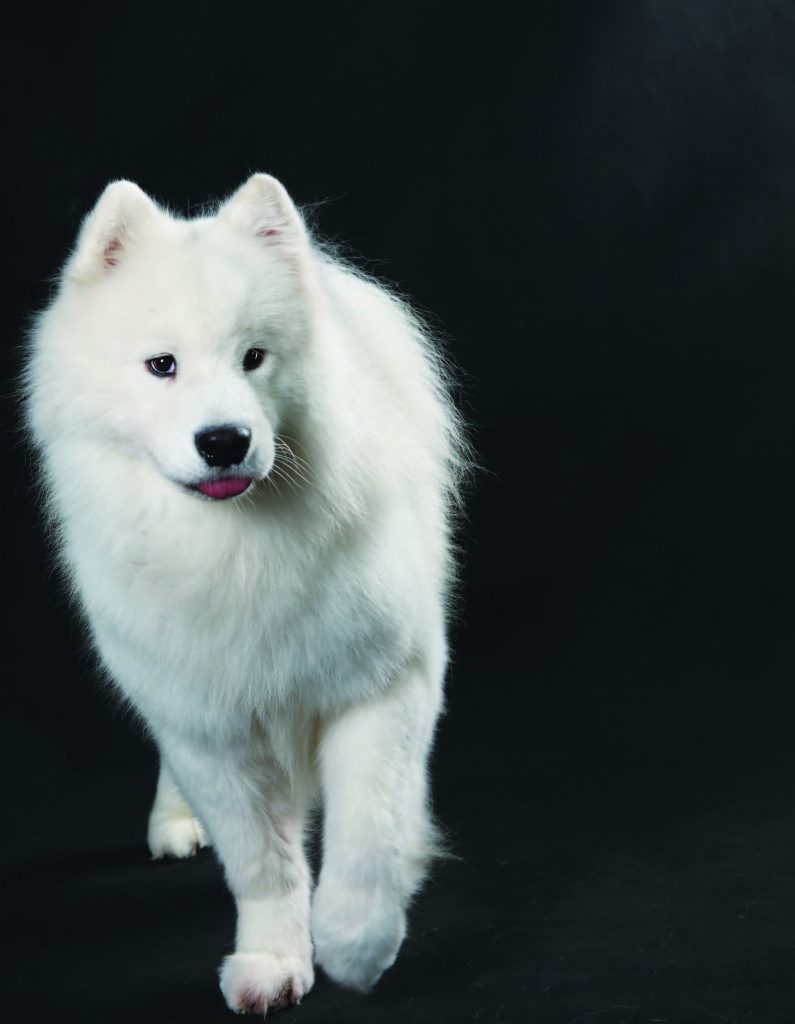
Philippine Grand Champion Polar Mist N Glacial Fire’s A Song of Fire N Ice “Ghost”
“Grooming your samoyed daily is necessary to keep them looking nice, clean and presentable. Daily brushing, using the line combing technique, ensures the removal of dirt that got stuck from the skin and coat. It also keeps the coat from matting,” Dr. Bernardo says. “Line brushing is pulling a handful of the coat to one side, usually towards the head or the back of the dog, with one hand while the other hand holding the brush or comb brushes the coat in the opposite direction of the other hand holding the coat and thus creating a line in between the two hands. This technique allows one inspect every inch of the dog’s body for any wounds, fungal infection or external parasites. Apart from that, allotting time for grooming also acts as form of perfect bonding moment for you and your Samoyed.”
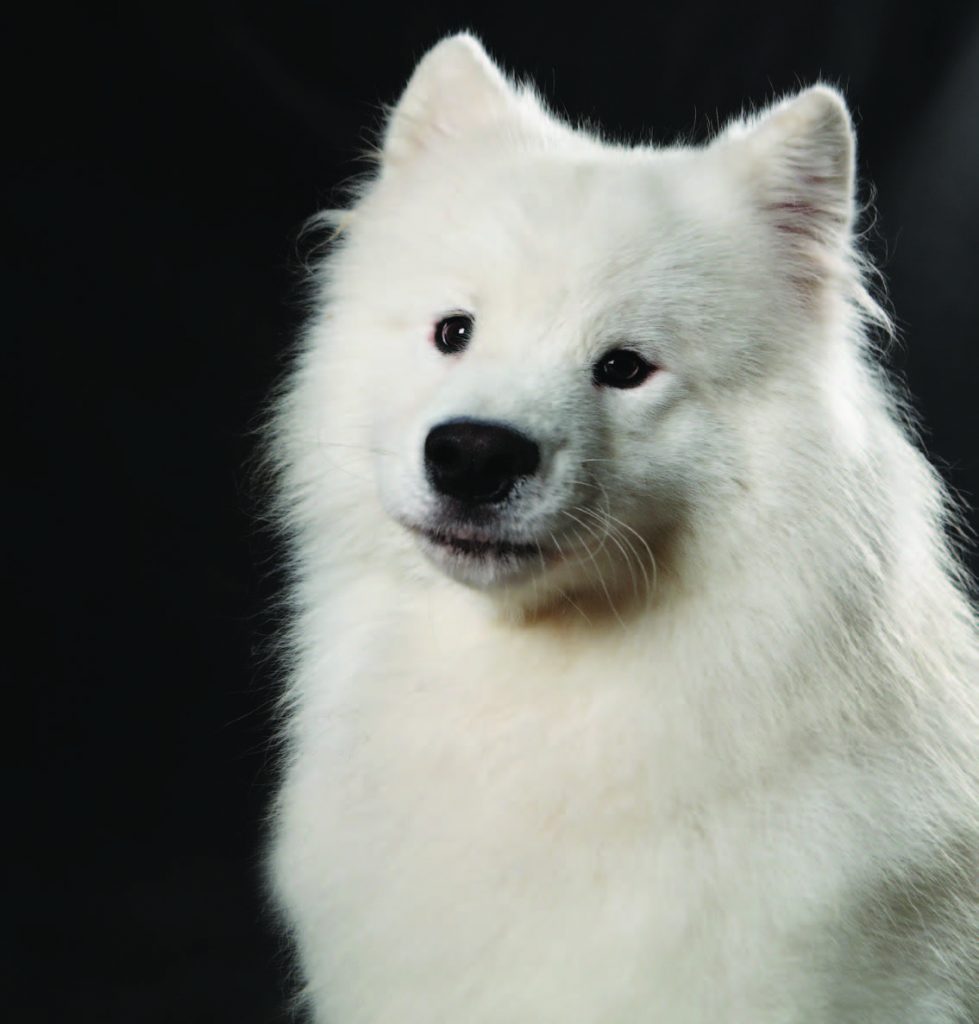
Philippine Grand Champion Polar Mist N Glacial Fire’s A Song of Fire N Ice “Ghost”
As with most breeds, brush your Samoyed’s teeth at least two to three times a week, trim its nails once or twice a month or when they get too long (it’s time to get the clipper out once you can hear your dog’s nails clicking on the floor), and regularly check its ears for mites and signs of infection, such as redness or foul odor. Clean the only outside of your dog’s ears with a damp cotton ball; leave the inside to your vet. Grooming sessions are also opportunities to check up on the Sammie’s overall health—keep on the lookout for sores, rashes, and signs of inflammation.
“Contrary to samoyeds raised in temperate countries wherein bathing is only done once every several months in between, samoyeds here in the tropics need to get a bath at least once a week or every two weeks. This is because in the Philippines we have a very humid environment and that humidity makes the coat sticky and more prone to dirt accumulation and staining,” Dr. Bernardo adds.
Feeding: A Good Diet for a Good Boy
A dog’s health is key to its happiness, and it’s no different for the Samoyed. It requires high-quality dog food that can either be home-prepared or commercially available. The amount of food depends on the dog’s age, size, and activity level. It’s recommended that Samoyeds be fed twice a day. Puppies tend to grow slow but steady, and proper nutrition is especially important at this time—a diet of 22-24% protein and 12-15% fat is recommended.

Philippine Grand Champion Polar Mist N Glacial Fire’s A Song of Fire N Ice “Ghost”
“A healthy Samoyed is a happy Samoyed. The top three things a samoyed needs to be happy and healthy includes balanced diet, grooming and exercise,” Dr. Bernardo says. “For a balanced diet, there are a lot of options available like raw diet (prey model) and high-end commercial dog food. Research what is the best and what will be easier and more accessible for you and your sammy. Always remember that a healthy dog from the inside glows on the outside.”
They love treats, but these should be given in moderation. It’s important to keep a close watch on the dog’s food consumption to avoid it becoming overweight. Clean, fresh water should be available at all times, especially during the warmer months.
Health and Fitness: Cool Runnings
The Samoyed enjoys socializing—an isolated Sammie is a sad, frustrated dog. It likes interacting with people and can be a great addition to family activities. Daily exercise is essential, whether this be leashed walks or yard playtime. Sammies then to be destructive when bored, and is prone to digging and chewing.
“Exercising the Samoyed, being a natural-born working dog, is very crucial because it needs to exhaust all the energy stored inside its body. A unexercised samoyed leads to a bored samoyed and a bored samoyed is hellfire unleashed to cause destruction,” Dr. Bernardo says. “Samoyeds should get at least 30 minutes of exercise or 5 km of walk daily. Not only that is good bonding time for both you, it is also a good way for your samoyed to explore the outside world, get acquainted with new sounds and environment and meet with people and other dogs.
Combining these three things would make a well-rounded samoyed that is both happy and healthy at the same time.”
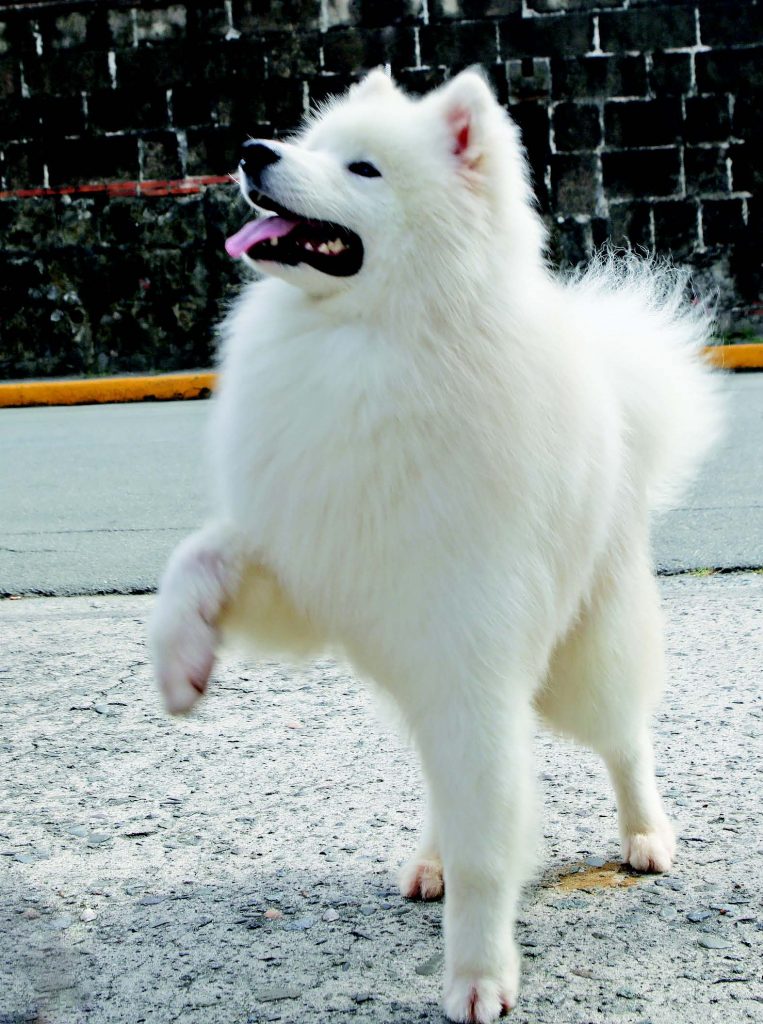
Philippine Grand Champion Polar Mist N Glacial Fire’s A Song of Fire N Ice “Ghost”
Keeping the Samoyed contained is important, as it has the tendency to roam when left on its own, leaving the dog to potential harm and causing undue stress to its owner. They need a firm hand in training, peppered with lots of love.
Sammies do well in almost all kinds of dog sports. Its history as a working dog makes it a good breed for obedience, carting, mushing, tracking, showmanship, even herding and flyball.
It is a fairly healthy breed, though it can be prone to illnesses like glaucoma, which can be treated with eye drops; Samoyed hereditary glomerulopathy, a kidney disease that can be fatal in males; diabetes, heart problems, and cancer.
Extra Challenge: Samoyeds in the Philippines
Despite being cold weather dogs, the Samoyed is one of the most popular breeds in the Philippines. “I think the main challenges in raising and showing samoyeds here in the Philippines are acclimatizing them to our warm and humid climate and maintaining their coat, which comes in white, cream, biscuit or a mix of those three, stain-free; the latter is what the usual dogs how exhibitors are afraid of and that is why for almost a decade, I’m always the lone samoyed exhibitor here in the Philippines. However, in the recent years, the breed is slowly gaining its popularity the conformation dog show world,” Dr. Bernardo says.
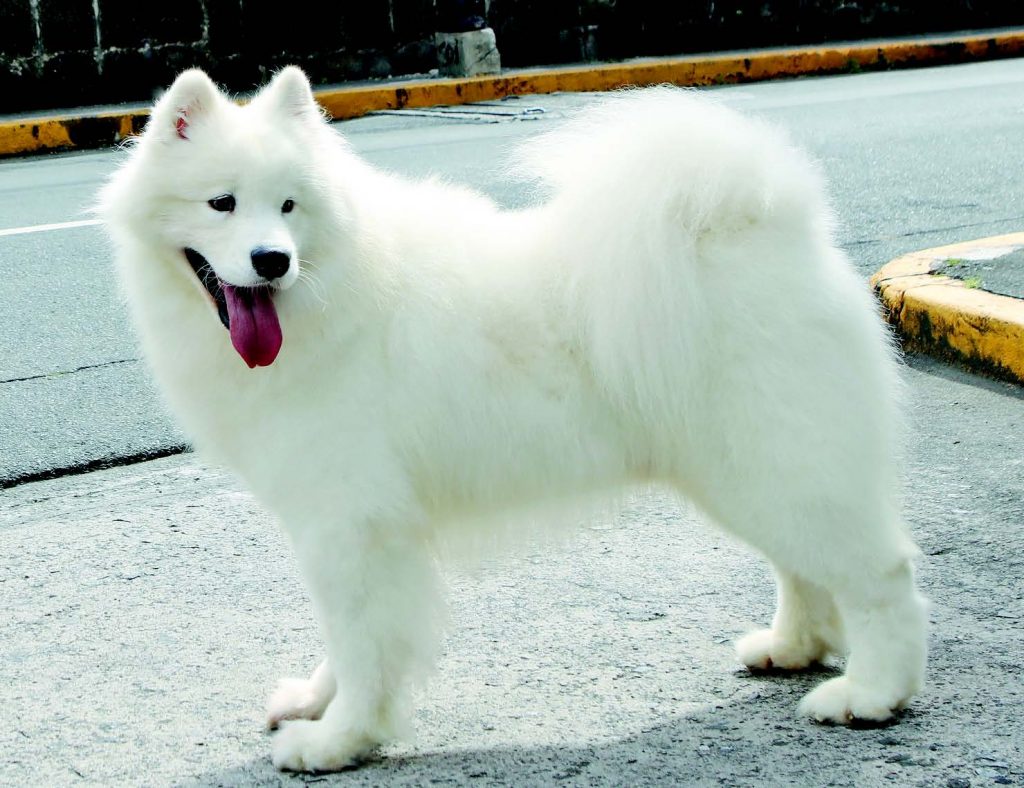
Philippine Grand Champion Polar Mist N Glacial Fire’s A Song of Fire N Ice “Ghost”
Their thick fur, combined with their love for the outdoors, means that special consideration must be made when caring for them in a tropical country. “Even though Samoyeds are very adaptable, they are still prone to heat stress and that is why scheduling the time of their walks, playtime and exercise outdoors is necessary,” Dr. Bernardo says. “My daily routine for my dogs is that they need to be outdoors during the coldest parts of the day like 4 am to 8 or 9am and then 5pm to 9 or 10pm.
“These schedule may change depending on the weather and the outside temperature but during these hours, they could go play and run outdoors on their lawn or get walked outside in order for them to exhaust the stored energy in them. Letting them have their own playtime and exercise would help them build muscle and be on their top condition. Also, walking them outside is a good form of socialization and a well socialized Samoyed usually does well during shows,” he adds.
If you plan on keeping a Samoyed, know from the start that regular grooming is an important part of keeping its coat smooth, sleek, and healthy. “In maintaining the coat in top condition, balanced nutrition, grooming and bathing all play a big factor,” Dr. Bernardo says. “Giving them a high-end dog food that works for them would make their coats grow and be in good condition. On the other hand, regular grooming and brushing will keep the coat tangle free while bathing with a whitening shampoo and a good quality conditioner will keep the coat clean and stain-free.”
The Samoyed is one of the oldest dog breeds in the world, and has had generations of being treated both as a work dog and as part of the family. It is also a large animal whose thick coat requires a lot of maintenance and grooming. When properly cared for, Samoyeds make loyal canine companions. No wonder the breed has remained recognizable, its popularity rarely waning.
Owning a Sammie: Factors to Figure Out
Are you thinking about getting a Samoyed as an animal companion? Veterinarian, breeder, and trainer Dr. Reuter King M. Bernardo, DVM shares some things to consider beforehand:
Commitment is a Must. “First of all, before deciding to get a Samoyed, one must research first about the breed’s characteristics, behavior and needs and then from there, try to see if they can commit to those things for the next 12 to 14 years or more.”
Choose a Healthy Dog. “If one finally decides to get a Samoyed, the top three things to consider includes health, temperament and soundness of structure.
Find a
Reputable Breeder. “The next step is to look for
reputable breeders, the people who breed for the betterment of the breed by
combining all the three aforementioned factors together. This kind of breeders
joins conformation dog shows to assess if their breeding stocks stay true to
the breed standard and could do their function as a breed. Furthermore, each
one of their litters is carefully planned and the breeding stocks used all have
passed the health clearances of the breed such as Canine Hip Dysplasia (CHD)
and Elbow Dysplasia (ED).”
Pick a Dog with Good Temperament. “On
another note, temperament is also very important. Samoyeds should be alert,
lively, sociable, friendly, playful and never shy nor aggressive. And just like
in humans, each Sammy also has its own unique characteristic or behavior and a
reputable breeder would know which one suits you the best.”
Pick the Right Puppy for Your Lifestyle. “For the soundness of structure, a reputable breeder can assess which puppy is good for show or just as pets based from the breed standard. The breed standard is like the bible for each breed and every breeder or breed enthusiasts should study it. It has all the necessary information on how a Samoyed should look like and as much as possible, everyone must breed dogs as close as possible to what it says. Breeding structurally sound and correct dogs is one big factor necessary for the continuation and preservation of the true samoyed form for the next generation. With that, it should also be noted that structure dictates function and it means that an unsound dog cannot do its purpose.”
Trivia:
- Most people mispronounce its name as Sa-MOY-ed, when it should actually be SAMmy-ed.
- Despite its popularity, many Pinoys mistake the Samoyed for another breed. “I think the top one should be that more Filipinos get familiar with the breed. Whenever we walk our dogs in public places, only a few knows the breed and most people often refer to them as a wooly Siberian Husky, a Chow-Chow, a polar bear, a giant Japanese Spitz and the list can go on and on,” Bernardo says.
- One of the oldest breeds in the world, the Samoyed is one of 14 dogs whose genetic footprint is closest to wolves.
- The Samoyed is not a hypoallergenic breed. “…They do shed a lot. In fact, there is no such thing as hypoallergenic breed and the main cause of allergic reactions to pets is not the fur per se but the dander, where the proteins from the urine and saliva of the animal have attached to, that sheds off from the skin,” Bernardo says.
- Aside from its smile, a feature that the Samoyed is known for is its tail, which curls over the back, falling only when the dog is relaxed.
- The Samoyed is actually a working dog. ““Although probably one of the most photogenic dog breeds gifted with the famous smiling faces and the lustrous silver-tipped coats, the Samoyed is an epitome of a true working dog. This breed is the jack of all trade of the nordic working dog breeds because they can do sledding, weight pulling, human babysitting and herding efficiently,” Bernardo says.
- In 1906, a dog named Moustan of Argenteau was the first Samoyed to be registered in the American Kennel Club.
Spotlight CHD: Have Your Sammie Checked for this Disease
“As a veterinarian, a breeder of Samoyeds, an advocate of doing health clearances and responsible breeding, I would like to take this opportunity to expound the importance of having health clearances done by discussing Canine Hip Dysplasia (CHD),” Reuter Bernardo, DVM says.
“CHD is a painful and debilitating disease (lameness) common in medium to large breed dogs that is due to the abnormal development of the socket of the hips; smaller breed of dogs are not exempted. It is a progressive polygenetic disease, which means hereditary and caused by multiple genetic factors from the sire and/ or dam, aggravated thru environmental factors such as slippery floors, lack of proper exercise, obesity and many others. The risk of developing and inheriting CHD from parents to puppies is high if the sire and/or dam has CHD; it is lower for pups with parents that have clearances for hip dyslpasia. That is why it’s recommended to not only breed dogs without CHD but to use dogs that are also cleared from CHD and came from a family or generations of dogs with no known CHD.
“Breeders should be more responsible by having their stocks screened before mating. Also, puppy-buyers should become more discerning in finding the right breed and breeders for them. Before deciding, ask yourselves first, is the breeder I am going to make a deal with had his breeding stocks cleared and is breeding dogs to partake in the preservation of the breed? If so, then you are on the right track but if not, think not only twice but a hundred times. Supporting backyard breeders and puppy millers who just keep on milking cash out of their dogs without thinking of the welfare of their stocks, the puppies they are going to produce and you as their buyer will not stop the cycle of greed. Not buying from those kind of breeders will help stop the increasing trend of dogs developing diseases such as CHD.
“And lastly, CHD clearance is possible in the Philippines but the test requires that the dogs be at least 2 years of age before taking the films. It is also one of the reasons why medium to large breed dogs MUST be at least 2 years of age before being used as a breeding stock. It is a fairly simple radiography procedure that just requires skill in positioning of the animal for a better view and evaluation of the hip. For a more detailed procedure, talk to your veterinarian and lead them to the Orthopedic Foundation for Animals (OFA) website. There are other methods such as PennHip but in the Philippines, OFA is the most accessible so far. With this, I hope people will strive to be more responsible by becoming part of the solution and not the problem. Let us end the cycle of producing genetically unsound dogs.”
This appeared in Animal Scene magazine’s February 2019 issue.






